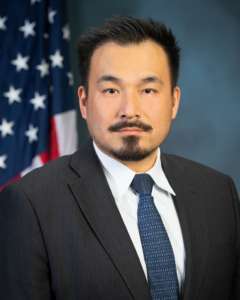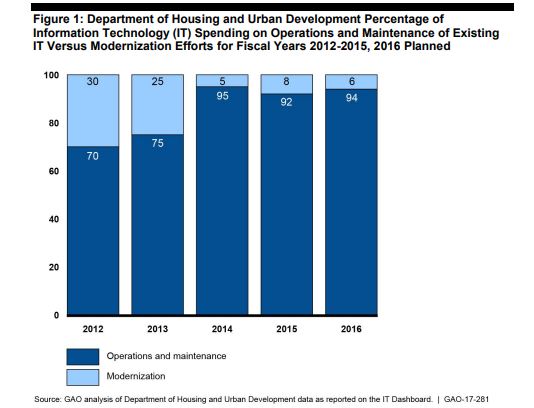

David Chow, the CIO of the Department of Housing and Urban Development, said the mission owners will have a bigger seat at the table than ever before to drive the...
Best listening experience is on Chrome, Firefox or Safari. Subscribe to Federal Drive’s daily audio interviews on Apple Podcasts or PodcastOne.
The decision by the Office of Management and Budget to name the Department of Housing and Urban Development as the next agency to use the Centers of Excellence (CoE) approach to modernize is both not surprising and a huge risk.
HUD has been trying to move to a new contracting approach to modernize its technology infrastructure for the better part of the last three years. It current contract, named HUD HITS — a $1 billion award made in 2005 to Lockheed Martin and Hewlett-Packard to run its infrastructure under a managed services contract — is now three years past its initial expiration date, providing the true definition of operations and maintenance.
And as one industry source told me several years ago, HUD remains a tough place to work because the ingrained culture at the agency continues to frustrate senior executives and the management support to change the culture also comes in waves.
So putting the spotlight on HUD under the CoE initiative means OMB and the General Services Administration is betting big on the top-level support that previous chief information officers didn’t have enough of over the last decade.
David Chow is HUD’s new CIO, coming over from the National Credit Union Administration about six weeks ago. He walks into the agency with a laundry list of priorities, at the top of which are the CoE initiatives and the application modernization project for which HUD received an extra $20 million from the Technology Modernization Fund (TMF).

Chow is the second CIO for HUD over the last year, replacing Johnson Joy, who resigned in March after only nine months.
“There has been a lack of consistency at the Office of the CIO’s level. There have been constant changes at the CIO leadership level. Each CIO comes in with a vision and it doesn’t translate to a long-term roadmap. That has been consistently an issue within the organization,” Chow said in an interview with Federal News Radio. “What the CoEs does a little differently here is we are actually having the business lead the overall effort. So let’s say one day if I’m not here, there’s still the roadmap that we are developing the foundation to be put in place. The CIO is actually interchangeable because once we have the roadmap, we can have other people help to execute the overall solution. This is part of the reason we are taking this initiative a little differently.”
The recognition by OMB that past IT modernization efforts at HUD led by Jerry Williams, the CIO from 2009 to 2013, and Rafael Diaz, the CIO from 2014-2017, failed to make a difference is why HUD is the perfect second agency to use the CoE approach. The Agriculture Department kicked off the CoE initiative in December 2017.
HUD’s challenges are as far as they are wide. Just take a look at what the Government Accountability Office reported in 2017, HUD would spend about 87 percent of its IT budget on operations and maintenance (O&M). This was actually good news considering HUD spent 95 percent, 92 percent and 94 percent on O&M during 2014, 2015 and 2016, respectively. Final data for 2017 and 2018 was unavailable.

During his tenure, Williams focused on improving HUD’s overall project management efforts as well as improving the CIO’s oversight of IT spending. Diaz picked up on some of what Williams did and focused on creating a more accurate view of the agency’s architecture. He wanted to do away with shadow IT and take control of IT investment planning.
Without a doubt, the efforts by Williams and Diaz made some progress. The Federal IT Dashboard shows 57 percent of all HUD IT projects are using iterative or agile development methodologies, while 79 percent of all IT investments are on time and on budget.
Chow said like many agencies HUD continues to struggle in two key areas: IT projects are not delivering capabilities quickly enough and there is a lack of strategic plan to meet mission goals.
“The CoEs are a great opportunity to make sure that we are engaging the business using the General Services Administration’s proven methodology to go through the assessment and really having the business leading the initial effort under Phase 1 to look at the business processes that could be convoluted and creating difficulties for the public to use, or also internally that it’s not providing the necessary benefits from an IT standpoint,” Chow said. “Phase 1 of the initiative is to have the business look at the overall process from the business aspect and what do we need to improve upon, and then translate that into IT requirements that in phase 2 we are looking to build out.”
Chow said this approach is much different because the CIO and program managers are not dictating the overall solutions.
HUD will take a similar, but different approach to that of the Agriculture Department, which moved into the second phase of the CoE effort earlier this summer.
Chow said HUD and GSA signed the interagency agreement last week to kick-off phase one, which will be a 6-to-8 month effort with a planned completion date by March 31.
Then, HUD will move to phase 2, which over the following 18 months will implement the plans developed under the initial planning stage.
In the meantime, HUD is holding an IT industry day led by its Office of Small and Disadvantage Business Utilization (OSDBU) later this fall where Chow plans to talk about his vision and roadmap.
Phase 1 efforts will look across five areas:
Chow said GSA is committed to helping out under phase 1, but it’s unclear the direction HUD will go for phase 2 right now.
“We have this convoluted way where each office has its own grant process. At the same time, there are a number of systems in place and there is not a good way of managing the grant process through applications, which is causing confusion to the public and causing unnecessary burden on the public,” he said. “Under the secretary’s OneHUD initiative, we want to bring everyone together to look at the 80 percent solution from the business process standpoint. We want to reengineer our current grant lifecycle process to that 80 percent solution. Then for the other 20 percent, we are looking to configure a tailored solution for each of the office’s needs.”
Chow said that 80 percent solution also will help HUD focus on the data using AI and other emerging technologies based on the risks to the agency, which, in turn, will help save the analysts time to review and process grant applications.
As HUD moves into phase 1 of the CoE effort and uses the money it received under the TMF, Chow said there are several short term goals to create confidence in this latest effort across the agency.
“I want to make sure we have transparency with our project management. I want to elevate our project managers. I want to make sure I welcome people to poke into our projects and ask necessary questions. I want to partner with program offices and stakeholders to make sure they have a critical seat at the table,” he said. “It’s not going to be me that is setting out the direction of the IT, but it’s going to be a collective effort working with the program office to make sure our IT investments aligns to the overall HUD objectives. It’s not for me to go out there and tell them what technology we want to us, or toy we want to buy. This should be a collective effort with the program office.”
Let’s hope the CoE approach combined with OMB and agency leadership support finally moves HUD into the 21st century with its mission systems as we’ve seen enough fits and starts over the last decade.
Copyright © 2025 Federal News Network. All rights reserved. This website is not intended for users located within the European Economic Area.
Jason Miller is executive editor of Federal News Network and directs news coverage on the people, policy and programs of the federal government.
Follow @jmillerWFED



